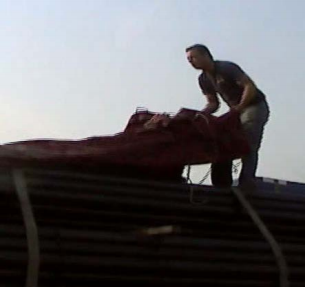A flat-bed driver was covering a load of steel with a large tarp. While pulling hard on the tarp to unfold it, the driver’s felt a sudden pain in his right shoulder. This was a recurrence of a previous shoulder injury also developed during tarping. This injury resulted in extensive therapy and two days off of work. The worker’s compensation claim was $25,000.

Recommended Practices
For the driver:
-
Use lighter and smaller tarps when possible.
-
Ask for help for the tarping and untarping.
-
Use a forklift to get the tarp on top of the load.
-
If a forklift is not available, get help from other workers and plan the lift. Keep the load close to the body, avoid twisting, and lift together.
-
Get a firm grip on the tarp. Do not just hold the ropes as they can slip or break.
-
Spread legs for balance before pulling tarp.
-
When conditions are windy, park close to buildings if possible so they provide some shelter to reduce the tarps from blowing.
-
Use three-point contact when getting on and off trailers. Climb on/off the flat bed via from the rear of the trailer or the catwalk. Don’t jump.
-
Wear proper shoes that are appropriate for the weather conditions.
-
Before pulling the tarp, move air under the tarp by lifting and lowering it to move air underneath.
-
Pull tarp with two hands. Keep hands close torso and about waist height. Pull towards the body.
-
Use arms, legs, and body weight to pull the tarp.
-
Wear gloves to prevent loss of grip.
For the employer:
-
Provide lighter and smaller tarps. Covering a load with three smaller tarps, compared to two large tarps results in lower physical demands.
-
Consider alternate tarping methods, such as sliders, rack and tarp kits, curtain side systems, roll-ups, and tarping machines.
-
Follow-up with regulations to provide restrictions to load sizes.
-
Instruct new drivers on basic strategies of tarping (e.g. where to place and unfold the tarp, how to tuck in the folds, where to connect bungees).
-
Purchase detachable ladders with handles or fold out steps to aid getting on and off trailers.
-
Provide help to drivers during tarping.
-
Provide fall arrest systems in a dedicated tarping area.